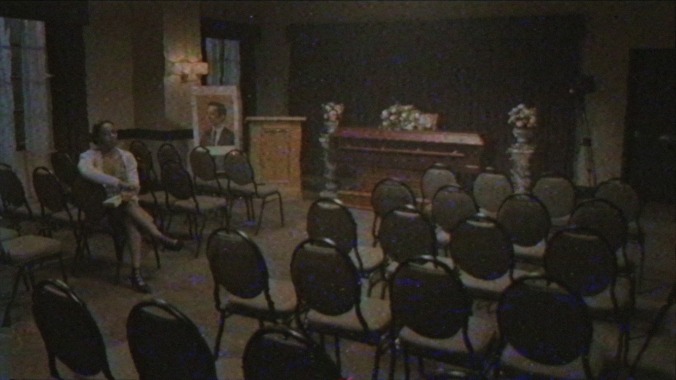There’s always been something rather backwards-looking about this run of fright-flick anthologies, superficially and somewhat arbitrarily built around a technology that became obsolete at the turn of the millennium. Yet V/H/S/94 is the first of the franchise whose segments—five of them total, counting a typically superfluous wraparound story—mostly appear to have actually been shot on VHS, or at least to have elaborately faked that aesthetic. We get muted colors, flutter, static, pop lines, scrolling wrinkles, and head-switching noise—all the glitches guaranteed to inspire a Pavlovian response in anyone who spent their Saturdays wandering the aisles of a Blockbuster.
Though every vignette is technically set in the ’90s, only the first, “Storm Drain,” much reflects that in content. It’s structured as a local news broadcast (complete with winking discussion of something called The Internet) that transitions into raw footage of a reporter (Anna Hopkins) shooting a segment on a local urban legend, a “rat man” said to dwell in the sewers of Westerville, Ohio. Written and directed by Chloe Okuno, who made the short film “Slut,” this opening entry is a throwback in another respect, boasting as it does some rather incredible practical effects work: a Xenomorphian beast that could have emerged from the Rob Bottin prosthetic monster factory. (Charitably, you could call Okuno’s ending a homage to one of the makeup maestro’s most memorable creature features, The Howling.)
While the original V/H/S had some conceptual variety, every segment here is a miniature monster movie; David Bruckner, who oversaw the project (but didn’t direct any of it), assures that each builds to an explosion of mayhem akin to the one he orchestrated in “Amateur Night,” the best of the first film’s episodes. “The Empty Wake,” from fellow series regular Simon Barrett, strands an assistant mortician (Kyal Legend) at a nocturnal service whose guest of honor proves less… inanimate than expected. Though the climax is predictable, it’s a nifty gross-out all the same. Less satisfying is the belated payoff of Lowlife director Ryan Prows’ “Terror,” in which some Michigan Militia types foolishly attempt to weaponize a supernatural entity they’ve captured. After a protracted setup meant to stoke our desire to see these white supremacists get theirs, the inevitable comeuppance passes too swiftly—though the main attraction, a toothy spawn of latex and elbow grease, is worth the price of admission.
One of the draws of found-footage is seeing how a filmmaker adapts to the built-in limitations of the gimmick. Barrett proves the most ambitious in this respect, filming “The Empty Wake” from three (mostly) stationary cameras, and building tension from the way he cuts among them; it’s a variation on the wonders the Paranormal Activity franchise has worked with fixed angles and restricted point-of-view. Meanwhile, mad-scientist riff “The Subject” commits to an almost entirely first-person vantage. Its maker, Timo Tjahjanto, co-directed the most nightmarish short under the V/H/S umbrella, the first sequel’s “Safe Haven.” Coursing with the same go-for-broke intensity, “The Subject” eventually becomes an extended gorefest, pitting a couple of unlucky lab experiments against an invading SWAT team. Unfortunately, this has the effect of making the framing segment from Knives And Skin director Jennifer Reeder, which also involves a police raid, feel all the more expendable.
Using the locked perspective for the purposes of empathy and outrageous video-game carnage, “The Subject” is the cream of this crop, despite how loosely it fits the decade-specific theme and analog vibe. (Many of the effects are blatantly digital, as is an aesthetic much more 2021 than 1994.) For as much as it works technology into its brand, the V/H/S franchise boasts the more simple, ageless appeal of campfire stories; every omnibus entry is really just a game of tension and release, of hide and then unleash the monster. To that end, file 94 somewhere between the inspired, crowd-pleasing bloodshed of the second film and the series-low ineptitude of the third, V/H/S Viral. As for its value as a way-back machine, that rests mostly on the singular imperfections of video itself. Are viewers really wistful for the days of pressing the tracking button on their VCR remote? Nostalgia, as they say, is a hell of a drug.

